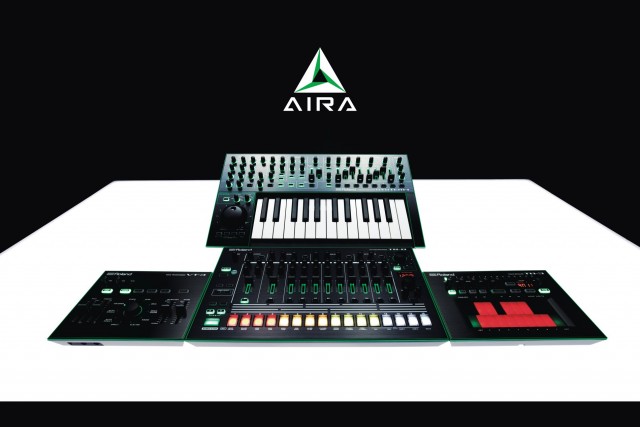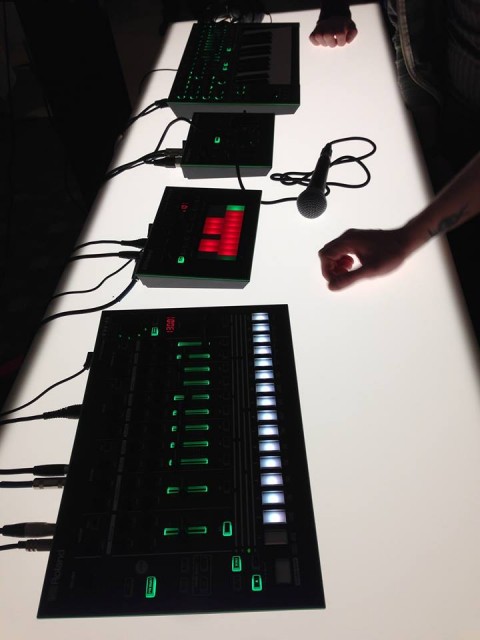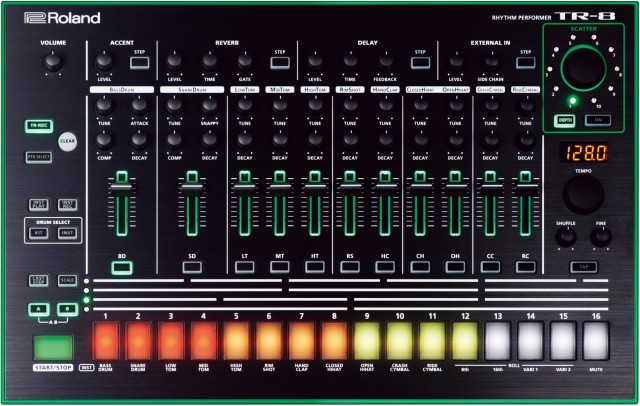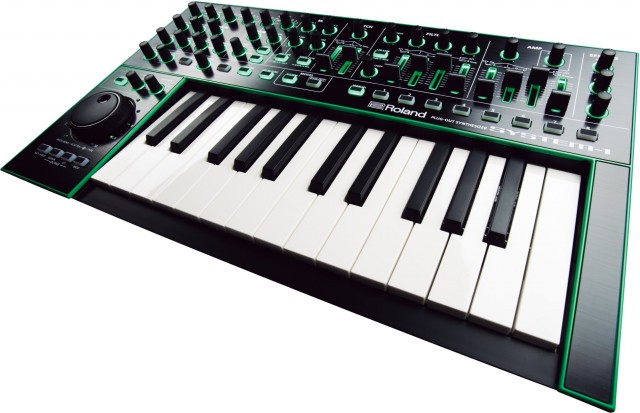It’s official: Roland’s much-teased line of four new products called AIRA are here. And they appear to represent a new course for Roland. They’re affordable and accessible in a way that we haven’t seen in recent products. But they’re also simultaneously closer to the sound of beloved vintage gear as they are more modern in taste and presentation.
Let’s get right to it. CDM got to speak to Roland prior to today’s announcement to get the details. And we’ll have more insight soon into the design process and approach to modeling. But let’s cover the basics.
This is component-modeled analog. All four products use the same analog modeling approach. It’s not superNATURAL, it’s not something you’ve heard from Roland before. It’s called Analog Circuit Behavior (ACB); it’s basically Roland’s own work on component modeling. Roland tells us that involves painstakingly modeling individual components on something like a 303 or 808, but also the interaction of those components, end-to-end. In other words, it’s Roland’s take on what is presently state of the art in emulating analog gear. Those models can sound nearly-indistinguishable from the originals, while offering flexibility that analog circuitry may not.
It’s pronounced “Aye, Rah.” Accent on the “Aye.” At least, that’s how Roland US is saying it. (Fully expect to hear “Air Rah,” “aye EE rah,” etc. Any Japanese-speakers care to guess? But since “Air Rah” sounds too much like “error” – much as we love glitch, probably not the idea – “Aye, Rah” should be the canonical pronunciation. You heard it here first.)
Availability is March and early summer. Expect TB-3, TR-8, VT-3 in March; we hope to review after MusikMesse. SYSTEM-1 will take longer, closer to May or (more likely) June.
If you like videos… Here’s what artists think.
And here’s a terrific video from our friends at Synthtopia, with Brandon Ryan from Roland USA (who talked in depth with CDM more recently – highly-knowledgeable product specialist and all-around nice guy):
There are four products.
CDM had been told preliminary pricing data, but it seems that’s not part of the announcement today. Pricing included here then is not official, but based on what we had acquired from contacts in Roland’s dealer network – expected street prices.
European pricing is the same – swap that US$ with a € (think import duty + VAT + currency conversion costs).
The four products:
SYSTEM-1 is really a synth/keyboard, not a modular (despite the name). It’s a new synth, but it’s also a controller for computer software modeling vintage Roland synths, and you can load those models onto the keyboard. Because you can load those models from software onto hardware, Roland dubs it “Plug-Out Synthesizer.” Price: US$599 – ish.
TR-8 Rhythm Performer. “Full reproduction” of both the 808 and 909, promising not just the sounds but details in behavior (like what happens when you have multiple instruments in accented steps). Price: US$499 – ish.
TB-3 Touch Bassline. Think a component-modeled 303 with a touch pad and new step sequencer. Price: US$299 – ish.
VT-3 Voice Transformer. It’s probably gotten the least attention, but this could be a big seller at this price. Multiple effects in one box: vocoder (a la VP-330), glitch, lo-fi, robot, auto-pitch, and voice-controlled synths. Price: US$199 – ish.
Roland is serious about getting attention for this. Apart from the teasers, Roland seems to have energized their dealer network and customers alike, to a point that people are excited about Roland in a way we can’t recall for years (outside eBay, that is). And the futuristic, Kubrick-style white-light demos are something you should expect more of, too. The demos in Anaheim even included these brightly-lit tables. And the products themselves use light-up accents, glowing with the colors of the vintage gear rather than painting those colors on plastic.
SCATTER. “Scatter” is a label applied to different, glitchy and unexpected effects on the AIRA series, including rhythmic decimators and pattern randomizers/slicers. Roland tells us that you can modulate those effects, and get different results on different content. We’re sniffing perhaps some interest in going after the EDM crowd, yes. But it also sounds like this effect could be shaped to different results, and it’s something new. Keep an eye out for “scattering” below. A number of the units (like the 303) include a lot of controls over both depth and pattern, so these may not always have to sound obvious, though this could be a new signature sound out of the AIRA line.
How does the sound compare? What’s the early review? Well, we’re awaiting review units – and SYSTEM-1 is due later. But You can pick up SonicState’s hands-on reviews (see videos below). And Teka has a video hands-on:
The world-exclusive, proper debut review went to MusicTech magazine. Read the whole review, or skip to the end for some sound quality analysis of TB-3 and TR-8:
http://www.musictech.net/2014/02/aira-3/
808:
909:
And the TB-3 + TR-8 together:
(thanks, readers, for all the tips!)
Let’s look at these by one, in reverse order now. They all use component modeling, they all have USB.
VT-3
The reboot. The Roland gear being emulated here: the VP-330 vocoder. The VT-3 is interesting in that it will test how good Roland’s component modeling is for an effect, for vocoding.
We already knew the VT-3 was a vocoder. But there are also a number of synths that can be controlled with your voice as input. The disappointing news: you don’t get something like a Space Designer, even though we saw one of those on the test bench in the videos. But expecting a US$199 street, this could be a big seller.
Choose from 9 different voice characters
o Pop and electro sounds with two distinct “AUTO-PITCH” effects
o VP-330-style VOCODER sounds without need for a keyboard
o Glitchy effects that sound like something broke (in a good way) with SCATTER o Loads of lo-fi character with MEGAPHONE and RADIO settings
o Synthetic sounding voices with the ROBOT button.
o Synths you can sing with SYNTH, LEAD, and BASS
• Change Pitch and Formant in real-time with smooth dedicated sliders • Large dedicated REVERB and MIX BALANCE sliders
• Save your three favorite settings for instant recall
• Footswitch control for live performance
• Pure green LEDs and brightly lit controls for great visibility
• Lightweight and durable construction for easy portability
• XLR standard combo jack with phantom power and 1/8” inch powered mic jack
• Stereo outputs can be configured as separate mono Wet/Dry channels
• USB audio interface with loopback recording to overdub vocals on existing tracks
• Great for podcasts and live web streaming
• USB bus powered
Did you spot the one non sequitur in there: “Great for podcasts and live web streaming.”
Um… I guess if your podcast requires you to speak like a robot, yes.
Anyway, don’t discount this. There isn’t a nicely-modeled vocoder at this price; you normally have to turn to software, which is inconvenient for a vocal effect.
Although, on the other hand … no one needs a vocoder?
TB-3
The reboot. No surprise here: the sound of the TB-3 is modeled on the TB-303. Roland’s “reboot” approach on the TB-3 is to rethink the step entry. They actually criticize the original in the copy for the new product: “the step entry on the original TB-303 was difficult to use, the keyboard was difficult to play, and special maneuvers were required for the shuffle functions.”
So, the TB-3 replicates the behavior of the sound of the instrument – the way the analog circuitry responded to different sequencing and to accent and slide parameters – but changed the input method.
The input is an apparently-new pressure-sensitive touch pad. It offers gestural controls that seem like the love child of a KORG ElecTribe and an iPhone. That is, you can control modulation with fingers, but also make gestures for commands:
• Envelope modulation and decay can be controlled with a single finger
• Switch patterns, transpose, and chain patterns with finger gestures
• Internally partitioned at keyboard intervals so it’s easy and natural to play in real-time
• XY PLAY (X: Continuous pitch change, Y: Volume, Press down on pad: Modulation)
The step sequencer has automatic pattern generation and random pattern modification, as well.
“Scatter” here does a lot: slice, reverse, gate, stutter, glitch. There are 8 variations and 10 levels of depth, so Scatter is something you can make your own.
On the emulation side:
• Meticulously crafted using a pristine unit, original spec sheets and archival data
• ACB technology models each component and every aspect of the original TB-303 sound
• Faithful recreation of the original saw and square oscillator waveforms
• Elements that characterize TB-303, such as attack, slide, and tie have been fully
reproduced, including how they interact with each other
• Authentic filter behavior with smooth response and authentic sound
On the “reboot” side:
• Pressure sensitive Touch Pad
• 134 captivating sounds including 4 oscillator effects-processed tones
o Bank A: Original TB-303 sounds
o Bank B: New synth bass sounds
o Bank C: New synth lead sounds
o Bank D: New sound effects
• Dedicated Tempo control with Shuffle and Tap Tempo
• Control built-in effects with smooth, responsive knobs
• 7 segment, 3 character LED display
• Seamless switch between pattern creation and performance • 16-step indicator lights to aid in pattern creation
• Pattern support for up to 32 steps
• Easy access to Shuffle control for bass lines that groove
• Enter steps manually or record real-time on the Touch Pad
• Change Step Count during playback to alter the length of phrases • Random pattern generation and pattern modification
• Pattern copy
Plus USB bus power, USB audio and MIDI, MIDI clock input. (Roland mentions receive, though oddly not send – but they say the AIRAs will sync with each other, so I think they intend send/receive clock.)
Remarkably, SonicState somehow managed to get a unit (something truly no one else has). They have a deep hands-on video review. Have a watch:
TR-8
The reboot. And you thought this was just a TR-808. Turns out, it’s also a TR-909. Here’s the odd part: the original Roland 909 used a combination of analog components and sampled PCM waves to make its sound. But Roland tells us the TR-8 is all component modeling. That means they’ve actually reconstructed sounds that were sampled with simulated analog circuits. We’re confirming the exact details of that, but it might mean the TR-8 take on the 909 is, in sound and control, more analog than the original. 909+?
Certainly, both the 808 and 909 have more control than the originals:
There are Tune and Decay knobs present on every instrument. (That was missing on 909 PCM sounds.)
Bass and Snare have dedicated Attack and Comp knobs.
The step sequencer allows per-step effects.
Here’s what Roland says about the original:
• Full reproduction of the original TR-808 and TR-909 rhythm machines based on original design spec sheets and detailed analog circuit analysis of various specimens including Roland’s own pristine units
• Newly developed Analog Circuit Behavior (ACB) technology allows part-by-part analyses and faithful recreation of tonality and behavior including the smooth variations of tone that occur when you work the controls of each instrument
• Obsessive attention to detail – like reproducing the original TR’s unique variations in tone that occur when multiple instruments are entered in accented steps
(Heh, actually, I expect that could lead to some complaints, as most the 808s and 909s out in the world are anything but pristine.)
And now, you get additional flexibility with those kits. Note side-chaining, per-step effects.
• Build dream kits made up of different instruments from the TR-808 and TR-909
• 16 stunning kits made up of 11 instrument types
• Control the intensity of the Accent function with a dedicated knob
• Per-step Gate Reverb and Delay effects with dedicated, real-time knobs
• Mix sources connected to the External Inputs
• Built-in Side Chain function creates rhythmic ducking and gating effects on External
Inputs with per-step control
• Two assignable analog outputs and full parallel outputs via USB for total mixing
flexibility
The step sequencer incorporates features of the 808:
• Faithful TR-REC behavior for pattern creation
• Large tempo control knob and a Fine adjustment knob for total tempo control.
• 16-step sequencer allows you to switch between variations [A] and [B] as well as
continuous playback
• Play drum instruments and record to steps in real-time
— but it also includes the kinds of sequencer features you would expect in a modern instrument. In fact, this set of features probably makes the best argument for why Roland really couldn’t reasonably re-release the original 808. KORG’s MS-20 mini last year may have had some idiosyncratic features, but today’s monosynths more or less behave in a similar way; it didn’t seem out of place. 1980s step sequencing, though, could seem properly like it fell out of the Stone Age, as instruments like the Machinedrum have moved on.
• Scatter lets you freak and tweak your grooves with real-time control and perfect sync
• 16 per-step pads with bold, full-color LEDs clearly show the current status
• Real-time pattern creation up to 32 steps
• Change the pattern step count seamlessly and on the fly
• Rec/Play modes have been eliminated enabling seamless pattern making and performance
• Seamless switch between step input and playing pads in real-time to create patterns • Real-time play of 4 different types of rolls (8th, 16th, VARI 1, VARI 2)
• Quickly Mute/Unmute individual instruments during performance or production
• Shuffle function from original TR-909 now has a knob for continuous real-time control • Pattern randomizing function induces creativity and brings spontaneity to live
performance
• 7 segment, 4 character LED display shows the current tempo and has Tap function • Pattern copy makes it easy to create pattern variations
Scatter on the TR-8, like the TB-3, includes “glitch, gate, truncate, and stutter” functionalities. You can switch between those patterns, and as on the TB-3, adjust different types and depth.
USB audio and MIDI, USB clock receive. Of course, the TR-8 requires more power, so don’t expect bus power.
And here’s SonicState with their TR-8 review:
SYSTEM-1
One of these things is not like the others.
The SYSTEM-1 is the real wildcard in the bunch. It doesn’t appear to have as much to do with the SYSTEM 100, 100M, or 700 – the three namesakes for this model. And some of its functionality is more tied to a computer.
Basically, the SYSTEM-1 is weird. We’ll get to see whether it’s weird in a good way.
Like the other AIRAs, the SYSTEM-1 is built around Analog Circuit Behavior. Here, that leads to two paths:
The new: the SYSTEM-1 includes an all-new synth, which Roland describes as a “fusion of beautifully classic and utterly modern synthesizer tones.” It’s not clear what the classic models are here, though. That is, unless you’re talking the vintage:
The retro: Roland promises a set of software recreations of Roland synths – a little like KORG’s Legacy Collection. Plug the SYSTEM-1 into your computer, and it becomes a controller for those plug-ins.
PLUG-OUT: Here’s where Roland breaks from the script. KORG essentially made you buy their emulations again if you wanted hardware that you could take away from your computer. Roland, for their part, is letting you take the same model in the software and load it into hardware. They’re calling it PLUG-OUT. (get it?)
Roland is starting with an SH-101 soft synth. You can run it in your host on your Mac or PC. Then, you can disconnect your SYSTEM-1 from your computer, and keep running the SH-101 model on the keyboard.
You can switch between the internal SYSTEM-1 synth and that SH-101 model. One thing you can’t do, Roland tells us, is load more than one plug-in on the keyboard – you have to reconnect to the computer and swap that way.
We don’t have much on this, and don’t expect the product until early summer, but here’s some information on the synth. Roland tells us they’re very excited about the arpeggiator/scatter.
• Four oscillators for buckets of fat synth tones
• Oscillator colors create continuous waveform changes from simple to complex
• All parameters can be controlled with physical knobs and sliders with LED
indicators
• Advanced Arpeggiator with SCATTER
• SCATTER jog dial offers 10 different phrase variations with dynamic, real-time
control over 10 stages of depth
• Variety of modulation functions including ring modulation, cross modulation and
oscillator sync
• -12dB and -24dB filter types with independent high pass filters
• Tone knob for easy tonal balancing
• Crusher knob for modern edge
• Integrated Delay and Reverb effect units
• Tempo syncing for LFO and Delay
• Innovative thin keyboard with 25 normal sized keys
• Comfortable to play and yet the most compact Roland synth ever
Reviews?
Absolutely.
We’ll get hands on these as soon as Roland can get them to us – no trade shows involved. See you then!












